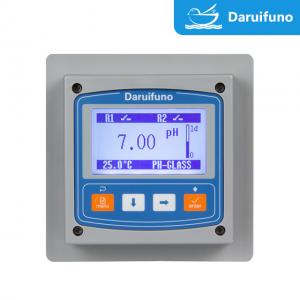
Add to Cart
Two Relays One 0/4~20mA Current Output Online PH/ ORP Controller For Sewage Or Drinking Water
Analog pH and ORP (Oxidation-Reduction Potential) controllers APX1-C1 are devices used to maintain and regulate the pH and redox properties of liquids. Use with pH and ORP sensors for precise control and monitoring.
Specification:
| Model | APX1-C1 | APX1-C1Z | |
| Principle | PH | Glass pH electrode (hydrogen ion concentration index) | |
| ORP | Platinum or gold electrodes (redox potential) | ||
| Display Range | PH | 0~14pH | |
| ORP | ± 2000mV | ||
| Temp | -10~150℃ | ||
| Resolution | PH: 0.01pH ORP: 1mV TEMP: 0.1℃ | ||
| Accuracy | 0.1% of the measuring range or ±0.02pH / ±2mV, take the larger one | ||
| Stability | 0.05% of measuring range every 24 hours without accumulation | ||
| Repeatability | Better than 0.1% of measuring range | ||
| Temp Compensation | Automatic or manual (NTC10K/PT1000) | ||
| Relay Output | Two SPST relays, Max. load 3A/250VAC, set high/low alarm, temp or clean control | ||
| Digital Communication | —— | A two-wire RS485 interface, Modbus RTU | |
| Current Output | A 0/4~20mA current Max. load 1000Ω | ||
| Language | English | ||
| Display | 128*64 3.2-inch graphic dot matrix LCD | ||
| Calibration Method | PH: 3 points ORP: 2 points | ||
| Protection Grade | IP66 | ||
| Enclosure Material | Enhanced ABS | ||
| Power Supply | AC: 100~240V 50/60Hz or DC:18~36V, | ||
| Dimension | 100*100*120mm (Hole size 92*92mm) | ||
| Electrical Interface | Reserve three M12*1.5 glan heads, the wire diameter is 3~6.5mm | ||
| Work Temperature | 0~60℃, RH<95%, non-condensing | ||
| Storage Temperature | -20~70℃, RH<55%, non-condensing | ||
| Installation | Panel | ||
| Weight | 450g | ||
| Power Consumption | Max. 3W | ||

Brief introduction:
Two SPST relays to set high and low alarms and control dosing
A 0/4~20mA current Max. load 1000Ω
The use environment includes but not limited to the following:
Laboratory environment:
pH and ORP sensors are commonly used in laboratories for chemical analysis, biological experiments and research applications. These environments are often tightly controlled to ensure high precision and accuracy.
Industrial production:
Chemical plants, pharmaceutical plants, food processing plants, and other industrial sites use pH and ORP sensors to monitor and control production processes. This helps ensure product quality, increase production efficiency and avoid unnecessary waste.
Environmental monitoring:
pH and ORP sensors are widely used in the field of environmental monitoring to detect and monitor the properties of water, soil, wastewater and pollutants. This helps protect the natural environment and human health.
Water treatment:
Drinking water treatment plants and wastewater treatment plants use pH and ORP sensors to monitor and regulate the pH and redox properties of water to ensure water quality is up to standard.
Pool and Spa:
pH sensors are used to monitor the pH level of swimming pool and spa water to maintain clean and safe water.
Agriculture:
The field of agriculture uses pH sensors to monitor the pH of the soil to determine the most suitable soil conditions for growing different crops.
Food and drinks:
The food and beverage processing industry uses pH sensors to monitor and regulate the pH of food products to ensure product safety and taste.
Aquarium:
pH and ORP sensors are used to monitor the quality of water in fish tanks, aquariums and aquarium exhibits to ensure the health of fish and aquatic life.
It should be noted that different applications may have different requirements for sensor accuracy, durability and environmental conditions. Therefore, when choosing pH and ORP sensors, you must consider the characteristics of the use environment and choose a suitable sensor model to ensure accurate and reliable measurement.